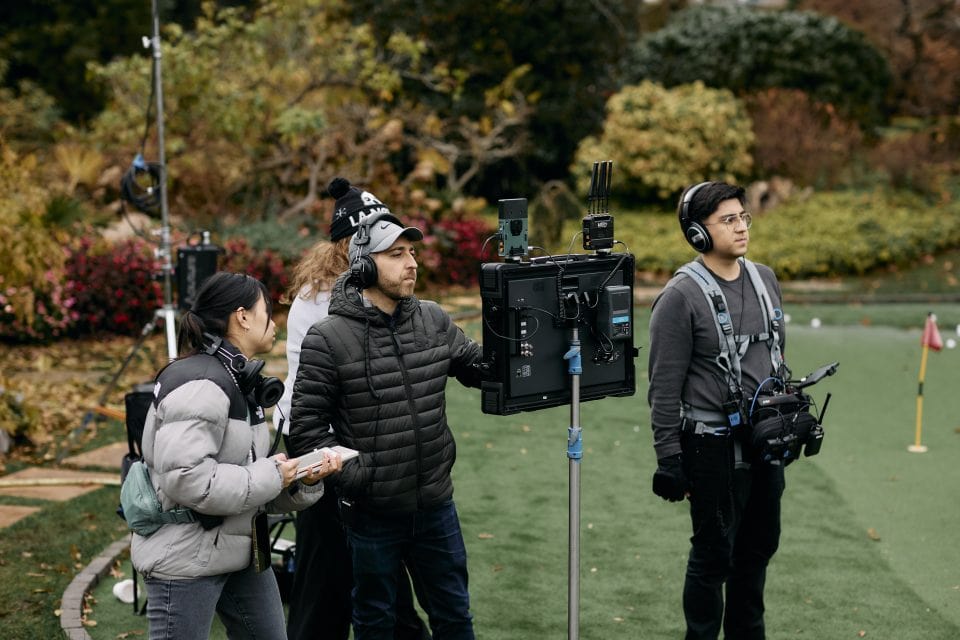Verticals on the rise
Also known as microdramas and ultrashorts, vertical shows, which are shot to be viewed on smartphones, are growing at a remarkable pace in Canada.
In September 2023, Italian-Canadian filmmaker Dom Cutrupi saw his first vertical show.
“A producer I was working with shared with me a piece of content — an episode,” Cutrupi recalls. “I looked at it, and I was like, ‘There's no way I'm going to do this.’”
Cutrupi had just finished shooting his second feature film and thought the concept of vertical shows — shooting in 9:16 for viewing on a smartphone, and fast cuts for ultrashort episodes of 60 to 90 seconds, looked, quite bluntly, “like crap.”
But the more he learned about the format and the potential employment opportunities that it brought to the Vancouver film industry, where Cutrupi worked, the more he warmed to it. “I often say, I’d rather be on the plane that’s taking off than on the one that’s going down,” Cutrupi says.
This came at a time when the industry was still recovering from COVID and the Writers Guild of America strike. By June 2024, Cutrupi was hired to direct a vertical series, My Poor Ex-Wife Is a Heiress, working with the same producer who showed him that first episode.
He’s been working on verticals with titles like Crashing Into My Magnate Ex and The Billionaire’s Second Wife ever since, and recently booked his 19th vertical show.
“It’s been fun since day one,” Cutrupi says. “I’ve been enjoying it. I’m loving this industry.”

Dramatic Plotlines Drive Viewership
The content of vertical shows is comparable to soap operas — dramatic plotlines with frequent cliffhangers that revolve around tropes, like a young girl falling in love with an older billionaire, or someone becoming estranged from their family. “I’m loving the challenges,” says Cutrupi. “Like, how do I make this ridiculous moment or stunt into something that is watchable and entertaining?”
Since his first exposure to verticals, Cutrupi has seen the industry evolve. “Last year, some scripts were very challenging to read. Like, it doesn't make sense why this character is showing up here,” Cutrupi explains. “But now, I understand the characters. It flows. I see the difference in cinematography and acting, too. Things are going better and we are all working to make it better.”
Filming vertical shows, also known as microdramas or ultrashorts, started in Canada about two years ago. But the format first emerged in China in 2018, where it exploded in popularity during COVID.
While the American short-form streaming platform Quibi, launched in April 2020, struggled to find an audience and shuttered just six months later, Chinese vertical-only streaming platforms like ShortMax, ReelShort and DramaBox flourished.
These platforms function as smartphone apps, tapping into the environment where most people find and watch vertical shows, and can be downloaded from various app stores or directly from the platforms’ websites. You can also watch some verticals on Instagram, YouTube and websites like Daily Motion.
- Read more: Is YouTube the new TV?
The Numbers are Impressive
Vertical platforms started commissioning productions at a dizzying pace.
By 2023, they reported more than 28 million downloads, representing 268 percent year-over-year growth. In 2025, microdrama revenues are projected to reach $9.4 billion (U.S.). There are more than 830 million viewers of microdramas in China alone.
Around 2023, Chinese production companies shifted their sights to North America, targeting English-speaking audiences. Chinese companies took their most successful microdramas, translated scripts from Chinese to English, and recreated them with North American actors.
According to Vancouver-based producer Jimmy Wu, verticals are poised to experience "exponential growth,” which is why he pivoted to this emerging format full-time, launching his production company, Vertical Film Vancouver, in May 2024.
“To date, I have produced over 21 verticals,” Wu says. He describes the productions as lower-budget — one-tenth of a “low-grade TV movie.” Verticals also film at a zippier pace. Shoots last just seven to 10 days compared to a typical two-week TV movie shoot. Wu says they cover about 12 pages of script per day, instead of the four-to-eight-page average for traditional TV movies.

In July 2025, the Vancouver Sun estimated that 20 vertical TV productions were being shot in Vancouver every month, representing hundreds of new job opportunities for actors and crew.
“It's creating a new industry,” says Wu. “It's creating jobs for people. It's creating different career paths for people. I used to be in the [traditional] TV industry, but there wasn't enough work in traditional TV for a sustained period of time. So I completely dropped that to focus on verticals. I can only imagine how many others are also following suit.”
Microdrama platforms work on a slightly different revenue model than big streamers. They typically allow viewers to watch a few episodes for free, then pay to “unlock” the rest of the series. Viewers can also earn credits by watching advertisements, and brand sponsorships add to revenues.
Advocating for Non-Unionized Sets
So far, most of these productions are non-unionized. The rapid growth of verticals, combined with their lower budgets and quicker pace, can result in less favourable work environments. That situation prompted casting director Monika Dalman to create the Vertical Film & Short Series Alliance (VFSSA) in June 2025 to ensure fair and ethical environments on vertical sets.
“I started more publicly educating actors on what their rights are as non-union actors and giving resources to them if they're ever in a situation that violates employment codes or human-rights code,” Dalman explains. “We knew we needed something that was going to serve as an advocacy group and resource for actors, regardless of union status.”
The VFSSA is in the process of creating a “V Seal” that, according to their website, verifies productions are “running above-board, safely and professionally, meeting clear standards for crew, talent, compliance and transparency.”
In July 2025, Dalman helped the union that represents B.C. actors sign its first deal with a vertical series. It’s a sign that more productions could become unionized, but Dalman says she’d be “shocked” if even 50 percent of productions became unionized, making the role of advocacy groups like the VFSSA all the more important.
Vertical TV Production is Spreading
While Vancouver is the format’s Canadian hub, productions are also happening in Toronto, and even Prince Edward Island, where Dalman says she has a client who has already made several verticals.
Dalman predicts major networks will enter the microdrama game soon. She points to the Disney Accelerator — an incubator program where Disney partners with emerging companies to develop new shows and products. In 2025, DramaBox was one of four companies chosen. There, filmmakers are being mentored on how to create verticals. This relationship could lead to Disney producing those stories and investing in DramaBox.
Wu says the streaming giants are “already in the [vertical] game, testing the waters.” He thinks the future of vertical shows is directly related to the decline of traditional TV. “Nobody that's on the younger side is really watching cable TV,” he says. “There are way too many restrictions when you can just go on YouTube and watch your own program on your own time.”
